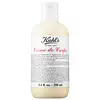What's inside
What's inside
 Key Ingredients
Key Ingredients

No key ingredients
 Benefits
Benefits

 Concerns
Concerns

 Ingredients Side-by-side
Ingredients Side-by-side

Water
Skin ConditioningPropylene Glycol
HumectantButyrospermum Parkii Oil
EmollientGlyceryl Stearate
EmollientCaprylic/Capric Triglyceride
MaskingIsopropyl Myristate
EmollientPEG-100 Stearate
Cetyl Alcohol
EmollientStearyl Alcohol
EmollientDimethicone
EmollientPhenoxyethanol
PreservativeCaprylyl Glycol
EmollientSodium Lactate
BufferingAllantoin
Skin ConditioningLactic Acid
BufferingParfum
MaskingAlpha-Isomethyl Ionone
PerfumingLimonene
PerfumingHexyl Cinnamal
PerfumingWater, Propylene Glycol, Butyrospermum Parkii Oil, Glyceryl Stearate, Caprylic/Capric Triglyceride, Isopropyl Myristate, PEG-100 Stearate, Cetyl Alcohol, Stearyl Alcohol, Dimethicone, Phenoxyethanol, Caprylyl Glycol, Sodium Lactate, Allantoin, Lactic Acid, Parfum, Alpha-Isomethyl Ionone, Limonene, Hexyl Cinnamal
Water
Skin ConditioningHydrogenated Polyisobutene
EmollientGlycerin
HumectantCoco-Caprylate/Caprate
EmollientPropylene Glycol
HumectantPEG-100 Stearate
Glyceryl Stearate
EmollientSqualane
EmollientStearyl Alcohol
EmollientHelianthus Annuus Seed Oil
EmollientButyrospermum Parkii Butter
Skin ConditioningMyristyl Alcohol
EmollientPPG-5 Pentaerythrityl Ether
EmollientPEG-5 Pentaerythrityl Ether
EmollientOlea Europaea Fruit Oil
MaskingSesamum Indicum Seed Oil
EmollientDimethicone
EmollientPhenoxyethanol
PreservativeIsopropyl Palmitate
EmollientCitric Acid
BufferingCera Microcristallina
Emulsion StabilisingPentaerythrityl Tetra-Di-T-Butyl Hydroxyhydrocinnamate
AntioxidantChlorphenesin
AntimicrobialPotassium Sorbate
PreservativeGlycine Soja Sterols
EmollientArgilla
AbrasiveXanthan Gum
EmulsifyingSodium PCA
HumectantAllantoin
Skin ConditioningPrunus Amygdalus Dulcis Oil
Skin ConditioningPrunus Armeniaca Kernel Oil
MaskingTheobroma Cacao Seed Butter
EmollientPersea Gratissima Oil
Skin ConditioningTocopherol
AntioxidantGlycine Soja Oil
EmollientLecithin
EmollientAloe Barbadensis Leaf Juice Powder
Skin ConditioningCI 40800
Cosmetic ColorantWater, Hydrogenated Polyisobutene, Glycerin, Coco-Caprylate/Caprate, Propylene Glycol, PEG-100 Stearate, Glyceryl Stearate, Squalane, Stearyl Alcohol, Helianthus Annuus Seed Oil, Butyrospermum Parkii Butter, Myristyl Alcohol, PPG-5 Pentaerythrityl Ether, PEG-5 Pentaerythrityl Ether, Olea Europaea Fruit Oil, Sesamum Indicum Seed Oil, Dimethicone, Phenoxyethanol, Isopropyl Palmitate, Citric Acid, Cera Microcristallina, Pentaerythrityl Tetra-Di-T-Butyl Hydroxyhydrocinnamate, Chlorphenesin, Potassium Sorbate, Glycine Soja Sterols, Argilla, Xanthan Gum, Sodium PCA, Allantoin, Prunus Amygdalus Dulcis Oil, Prunus Armeniaca Kernel Oil, Theobroma Cacao Seed Butter, Persea Gratissima Oil, Tocopherol, Glycine Soja Oil, Lecithin, Aloe Barbadensis Leaf Juice Powder, CI 40800
 Reviews
Reviews

Ingredients Explained
These ingredients are found in both products.
Ingredients higher up in an ingredient list are typically present in a larger amount.
Allantoin is a soothing ingredient known for its protective and moisturizingg properties. Because of this, it is often added to products with strong active ingredients.
Studies show higher concentrations of this ingredient can promote wound healing.
Though it can be derived from the comfrey plant, allantoin is produced synthetically for cosmetic products to ensure purity.
Learn more about AllantoinDimethicone is a type of synthetic silicone created from natural materials such as quartz.
What it does:
Dimethicone comes in different viscosities:
Depending on the viscosity, dimethicone has different properties.
Ingredients lists don't always show which type is used, so we recommend reaching out to the brand if you have questions about the viscosity.
This ingredient is unlikely to cause irritation because it does not get absorbed into skin. However, people with silicone allergies should be careful about using this ingredient.
Note: Dimethicone may contribute to pilling. This is because it is not oil or water soluble, so pilling may occur when layered with products. When mixed with heavy oils in a formula, the outcome is also quite greasy.
Learn more about DimethiconeGlyceryl Stearate is a mix of glycerin and stearic acid.
It is used to stabilize the mixing of water and oil ingredients. By preventing these ingredients from separating, it can help elongate shelf life. It can also help thicken the product's texture.
As an emollient, it helps soften skin and supports barrier-replenishing ingredients.
In cosmetics, Glyceryl Stearate is often made from vegetable oils or synthetically produced.
This ingredient may not be fungal-acne safe
Fun fact: The human body also creates Glyceryl Stearate naturally.
Learn more about Glyceryl StearatePeg-100 Stearate is an emollient and emulsifier. As an emollient, it helps keep skin soft by trapping moisture in. On the other hand, emulsifiers help prevent oil and water from separating in a product.
PEGS are a hydrophilic polyether compound . There are 100 ethylene oxide monomers in Peg-100 Stearate. Peg-100 Stearate is polyethylene glycol ester of stearic acid.
Phenoxyethanol is a preservative that has germicide, antimicrobial, and aromatic properties. Studies show that phenoxyethanol can prevent microbial growth. By itself, it has a scent that is similar to that of a rose.
It's often used in formulations along with Caprylyl Glycol to preserve the shelf life of products.
Propylene Glycol is an odorless, colorless liquid. As a humectant, it helps skin retain moisture. It also aids in delivering active ingredients.
Another role of this ingredient is preventing a product from melting or freezing. Propylene glycol also adds antimicrobrial properties to a product, elongating product lifespan.
This ingredient is considered an organic alcohol and commonly added into both cosmetics and foods.
Those with sensitive skin or conditions may develop a rash when using this ingredient.
Learn more about Propylene GlycolStearyl Alcohol is a type of fatty alcohol from stearic acid. It is a white, waxy compound used to emulsify ingredients.
Fatty Alcohols are most often used as an emollient or to thicken a product. Emollients help soothe and hydrate the skin by trapping moisture.
They are usually derived from natural fats and oils and therefore do not have the same drying or irritating effect as solvent alcohols. FDA allows products labeled "alcohol-free" to have fatty alcohols.
Learn more about Stearyl AlcoholWater. It's the most common cosmetic ingredient of all. You'll usually see it at the top of ingredient lists, meaning that it makes up the largest part of the product.
So why is it so popular? Water most often acts as a solvent - this means that it helps dissolve other ingredients into the formulation.
You'll also recognize water as that liquid we all need to stay alive. If you see this, drink a glass of water. Stay hydrated!
Learn more about Water